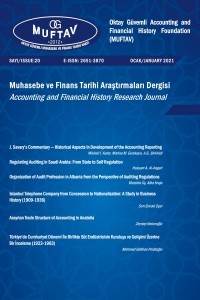Osmanlı’dan Cumhuriyet’e Bütçe Denemelerinin Muhasebe Açııindan İncelenmesi ve Bir Örnek
Anadolu coğrafyasında çok eskiden beri gelişmiş muhasebe sistemleri kullanılmıştır. Özellikle Osmanlı Dönemi’nde ileri düzeye taşınan muhasebe düzeni, imparatorluğun merkezi devletçi yapısı sebebiyle gelişemeyen özel işletmelerden dolayı devlet muhasebesi sınırları içerisinde kalmıştır. Kuruluşundan itibaren geliştirilerek kullanılan merdiven yönteminin 18. yüzyıldan itibaren ihtiyacı karşılayamadığı görülmüş ve 19. yüzyılın ikinci yarısında muhasebe ve mali sisteme yönelik önemli değişiklikler yapılmıştır. Bu değişikliklerin birçok yönü olmakla birlikte bu araştırmada özellikle ilgili dönemde muhasebe ile ilgili önemli ve nadir belgelerden sayılan devlet bütçeleri incelenmiştir. Tanzimat Dönemi öncesinde modern anlamda bir bütçeleme söz konusu olmamakla birlikle yüzlerce yıldır kullanılan tahakkuk muhasebesi yöntemi bütçe uygulamalarını kolaylaştırmıştır ve 20. yüzyıldan itibaren modern bütçe uygulamaları söz konusu olmuştur. Bu araştırma da söz konusu değişikliklerin özellikle muhasebeyi ilgilendiren yönleri ele alınarak incelenmiş ve örnek bütçe karşılaştırmasına yer verilmiştir.
Anahtar Kelimeler:
Osmanlı’dan Cumhuriyet’e Devlet Muhasebesi, Bütçe ve Muhasebe
Examination of Budget Studies from Ottoman Empire to Republic of Turkey in Terms of Accounting and A Case Study
Advanced accounting systems have been used for a long time in Anatolia. Especially in the Ottoman Empire period, these systems remained within the boundaries of state accounting since private companies could not develop because of strict ruling of the central statist structure of the Empire. In addition, the ladder method, which is a special method used in the Ottoman Empire, has evolved over time, but it has not been able to meet the needs of the18th century and significant changes have been made towards the accounting and financial system in the second half of the 19th century. Although there are many aspects of these changes, this study examined the effects of these changes on the state budget in particular. Although there was no modern budgeting prior to the Tanzimat period, the accrual accounting method used for hundreds of years and facilitated budget implementations and modern budget approach had started to be used since the 20th century. In this study, especially the accounting aspects of these changes explained and the budget published in 1922 and 1926 was examined.
___
- Çabuk, A., Arıkan, T.S., (2013. “Transition from the Merdiban Method to Double Entry Bookkeeping For State Accounting Applications in the Ottoman State - 19th Century”, Accounting and Financial History Research Journal, 4, 168-196.
- Çataloluk, C., (2015). “Budget of the Ottoman Empire” Journal of the Human and Social Science Researches, 4-3, 497-515.
- Çiçek, H. G., Dikmen, S., (2015) “Historical Evolution of Budget and Power of Purse in the Ottoman State”: The International Journal of Economic and Social Research, 11 – 2, 83-98.
- Coşar, N., (1995). “Cumhuriyet Döneminde Denk Bütçe Politikasına Geçiş“, Atatürk Araştırma Merkezi Dergisi, 11-31, 239-257.
- Dikmen, S., (2015). “Bibliography Trial on Ottoman Budgets”, Journal of the Human and Social Science Researches, 4-3, 810-823.
- Güvemli, O., (2000), Türk Devletleri Muhasebe Tarihi, Tanzimat’tan Cumhuriyet’e, Chamber of Sworn-in Certified Public Accountants of Istanbul: İstanbul.
- Güvemli, O., (2001). Türk Devletleri Muhasebe Tarihi, Cumhuriyet Dönemi, XX Yüzyıl, Proje Danış: İstanbul.
- Güvemli, O., (2018). Çift Yanlı Kayıt Yönteminin Kısa Tarihi ve Bir Teori, Ordu Chamber of Certified Public Accountants: Ordu.
- Güvemli, O., et al., (2019). History of Middle East Accounting, Volume:III, Turkish Court of Accounts: Ankara.
- Güvemli, O., Güvemli, B., (2006). “Osmanlı’dan Cumhuriyet’e Muhasebe Düşüncesinin Gelişimi” Journal of Financial Analyze, Certified Public Accountanst of Istanbul, 76, 275-290.
- Güvemli, O., Güvemli, B., (2015). “Effects of Turkish Commercial Codes on the Development of Turkish Accounting Thought”, Accounting and Financial History Research Journal, 8, 26-50.
- Güvemli, O., Güvemli, B., (2016). “Waqfs and State Accounting Systems in the Ottoman Administration”, Journal of Waqfs Turkey, 46, 9-21.
- Güvemli, O., Toraman, C., Güvemli, B., (2014). State Accounting in the Ottoman Empire - Anatolian Accounting Recording Culture, PCAOB Turkey Press: Ankara.
- Karabulut, R., Apak, S., Erol, M., (2019). History of Middle East Accounting, Volume: II, Turkish Court of Accounts: Ankara.
- Karaman, K., Pamuk, Ş., (2009). “Avrupa Devletleriyle Bir Karşılaştırma Osmanlı Bütçeleri ve Mali Yapının Evrimi”, Toplumsal Tarih Dergisi, 191, 26-33.
- Karta, N., (2018). “Budget Practices and One-Year Salary Case in the Ottoman Empire” Press Academia Procedia, 7, 403-407.
- Kaya, D.G., Durgun, A., (2009). “Fiscal Policies of Ataturk for the Period of 1923–1938: Budget and Tax Practices”, SDÜ - Faculty of Science and Letters Journal of Social Sciences, 19, 233-249.
- Kılıçer, E., Peker, İ., (2018). “The Role of Government Accounting in the Management of Government Budget: Turkey Evaluation”, Journal of Accounting and Taxation Studies, 11-1, 77-92.
- Öner, E., (2009). Osmanlı Devleti 1912 Yılı Hazine Genel Hesabi ve Kesin Hesap Kanunu Tasarısı, Maliye Bakanlığı Strateji Geliştirme Başkanlığı, Press No: 2009/398: Ankara.
- Özerhan, Y., Erkan, M., Nazlıoğlu, B., (2013). “Ledgers and Reports Written By Stairs Method in Ottoman Archives”, Accounting and Financial History Research Journal, 5, 88-120.
- Sahillioğlu, H., (1967). "Savaş Yılı Buhranları", İktisat Fakültesi Mecmuası, 27 (1-2), 75–111.
- Sipahi, B., Küçük, İ., (2011). “Effects of Turkish Commercial Laws to the Development of Accounting in Their 160 Years History”, Accounting and Financial History Research Journal, 1, 181-193.
- Siverekli, E., (2002). “Osmanlı Devleti’nde Bütçe Uygulamaları”, Erciyes University Journal of Faculty of Economics and Administrative Sciences, 18, 97-122.
- Yücel, G., (1982). “Muhasebenin Çağlar Boyunca Gelişimi”, Journal of Istanbul University Business School, 11-1, 217-227.
- ISSN: 2146-4928
- Yayın Aralığı: Yılda 2 Sayı
- Başlangıç: 2011
- Yayıncı: Oktay Güvemli Muhasebe ve Finans Tarihi Vakfı (MUFTAV)
Sayıdaki Diğer Makaleler
Dünden Bugüne Belirsiz Dünyada Muhasebe
Avrupa Birliği Hibelerinin Türkiye'deki Uygulamalarında Karşılaşılan Muhasebe ve Denetim Sorunları
Türkiye’deki Muhasebe Uygulamalarının Tarihsel Gelişimi ve Günümüzdeki Durumu
Osmanlı’dan Cumhuriyet’e Bütçe Denemelerinin Muhasebe Açııindan İncelenmesi ve Bir Örnek
Özkan SARISOY, Çağla DEMİR, Burcu ADİLOĞLU
Eregli Coal Company as the First Corporate Practice in The Ottoman State
Aromasıyla Dünyayı Kuşatan Marka: Kurukahveci Mehmet Efendi ve Mahdumları 1871-2019
Dursun Ali YAZ, İlker Kıymetli ŞEN
Kurumsal Yönetim Anlayışı Kapsamında Türkiye Denetim Standartlarının İncelenmesi
